Miso soup is an essential part of Japanese daily meals, served at breakfast, lunch, and dinner across Japan. A single bowl of miso soup contains 35-50 calories and provides about one-sixth of daily salt intake when made with 13 grams of miso. Despite its simple ingredients, this everyday soup delivers both flavor and nutrition, which is why it continues to be a key part of Japanese dining today.
What is Miso Soup?
At its heart, miso soup combines two fundamental elements of Japanese cooking: dashi (出汁, soup stock) and miso paste (味噌). Traditional dashi brings the crucial umami foundation through carefully prepared kombu (kelp) and katsuobushi (dried bonito flakes). The miso paste, made from fermented soybeans, adds depth, complexity, and essential nutrients to the soup. Japanese cooks then enhance this base with seasonal ingredients, creating countless variations throughout the year.
About Miso Paste
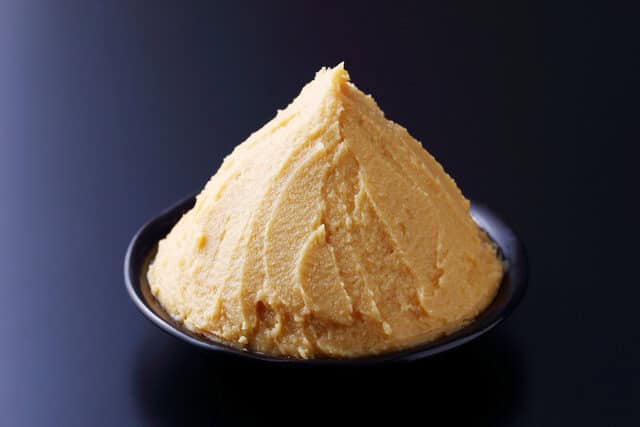
The foundation of miso soup lies in its namesake ingredient – miso paste. Japanese miso producers have developed distinct varieties over centuries, each with unique characteristics that contribute differently to the final soup. The three main categories of miso reflect Japan’s mastery of fermentation techniques and regional preferences in taste.
Rice miso, known as kome miso, represents the most widely used variety across Japan. It offers a balanced flavor profile that works well in everyday cooking. Barley miso (mugi miso) brings a distinctive sweetness and aroma to soups, while soybean miso (mame miso) provides the deepest, most complex flavor profile of all varieties.
Different types of Miso
You might be thinking miso is just miso, right? Well, actually, there are quite a few different types, and each one brings something special to your soup:
White Miso (Shiro)
If you’re just starting out with miso soup, this is your go-to. It’s a bit sweet, super friendly on the palate, and won’t overwhelm your other ingredients. I always recommend this one to my friends who are trying miso for the first time.
Good for light ingredients like tofu, wakame, and leafy vegetables. The soup turns out gentle and slightly sweet. It’s a good choice when you want the taste of your ingredients to come through clearly.
Red Miso (Aka)
Now, this is what I’d call the bold cousin of white miso. It’s been fermented longer, so it’s got a much stronger personality. When you want a soup that really warms you up on a cold day, this is your best friend.
Best with stronger-tasting ingredients like root vegetables or pork. Makes a richer soup that’s especially good in winter. Some people might find it a bit strong at first, but it’s great once you get used to it.
Mixed Miso (Awase)
Can’t make up your mind? No problem! This one’s like getting the best of both worlds. Japanese home cooks often reach for this type because it’s so versatile.
Types of Dashi
You might be wondering what makes Japanese soup bases so different from others. Well, let me introduce you to dashi – it’s basically the backbone of Japanese cooking. Without it, your miso soup would be missing that special something that makes it truly Japanese.
- Kombu Dashi: This one’s made from seaweed, and guess what? It’s perfect if you’re vegetarian! You’d be amazed at how much flavor you can get from just soaking some dried kelp in water.
- Bonito Dashi: Here’s what most Japanese families use at home. It’s made from dried fish flakes, and it adds this amazing smoky, savory flavor that’s hard to describe until you try it.
- Mixed Dashi: Want the best of both worlds? A lot of home cooks go for this combo. I personally love using this because you get such a rich, balanced flavor.
History of Miso Soup

Origins in the Heian Period
The history of miso soup is intrinsically linked to the development and spread of miso itself in Japanese culture. The earliest documented appearance of the word “miso” dates back to the Heian period (794-1185). During this era, miso wasn’t used as a seasoning but rather existed as a preserved food made from salted soybeans, eaten directly as a preserved food. Interestingly, it was so valuable that it served as a form of salary for aristocrats and was presented as tribute, placing it well beyond the reach of common people.
Innovation in the Kamakura Period
A significant transformation occurred during the Kamakura period (1185-1333) with the introduction of grinding bowls from mainland China. This new tool enabled people to grind miso into a paste that could be dissolved in water, leading to the creation of miso soup as we know it today. This innovation marked a crucial shift in miso’s role from a preserved food to a seasoning. During this period, the warrior class promoted simple living, leading to the development of “ichiju-issai” – a meal style consisting of rice, soup, one side dish, and pickled vegetables. This format spread widely among the samurai class.
Popularization in the Muromachi Period
The Muromachi period (1336-1573) saw another significant development as farmers began producing miso at home. Through continuous experimentation with cooking methods among common people, most of the miso dishes we know today were established. This period also saw miso soup’s popularity continue to grow. The versatility of miso extended beyond soup, and by the Edo period (1603-1867), it had become an indispensable part of Japanese cuisine, leading to a substantial increase in miso merchant businesses.
Wartime Innovation
An interesting historical note suggests that miso soup may have originated as a military provision during the Warring States period. There are accounts of it being an effective measure against heat exhaustion, and it could be prepared easily in large quantities. One fascinating preparation method involved simmering taro stems in miso – soldiers could simply add hot water to create an instant soup in their helmets. According to legend, Ishida Mitsunari, a famous warlord, noted that “drinking hot water mixed with grilled miso could stave off hunger all day even without rice.”
The Edo Period Staple
By the Edo period, miso soup had become a staple in nearly every household. For common people, the combination of rice, miso soup, and pickled vegetables formed the basic meal structure. In Edo city, street vendors known as “shijimi-uri” (clam sellers) and “natto-uri” (fermented soybean sellers) would walk the streets each morning, selling ingredients for people to make their morning miso soup.
Modern Evolution
In the modern era, particularly after the Showa period (1926-1989), miso production became industrialized, leading to packaged products and instant miso soup varieties that could be stored in refrigerators. Despite these modern innovations, miso soup remains a fundamental component of Japanese cuisine, commonly served in set meals at restaurants alongside rice and side dishes, maintaining its cultural significance in contemporary Japanese society.
Ingredients in Miso Soup
Tofu (豆腐)

Tofu is probably the most common ingredient you’ll find in miso soup across Japan. Both soft and firm tofu work well, each offering a different texture to the soup. For a simple but satisfying combination, try adding enoki or shimeji mushrooms. If you like seafood, small clams go really well with tofu and add natural sweetness to the soup. For something different, adding some kimchi gives the soup a nice spicy kick. Since tofu has a mild taste, it works better with lighter miso types that won’t overpower it.
Daikon Radish (大根)

During winter months, daikon makes the soup especially warming and filling. When cooked until soft, it becomes slightly sweet, which goes well with miso’s salty taste. Many people like to add carrots and fried tofu along with daikon for a more filling soup. Adding mushrooms brings extra flavor too. Because daikon has a stronger taste, you can use red miso without worrying about losing its flavor.
Seasonal Greens (季節の葉物)

Different greens come and go with the seasons – spinach in winter, morning glory in summer. These vegetables cook quickly, so they’re good when you’re in a hurry – just put them in right before serving. They taste great with fried tofu or a few small clams. Light colored miso usually works best with greens to keep the fresh taste.
Mushrooms (きのこ)

Mushrooms are good in miso soup all year round, but they’re especially nice in autumn. You can use just one type or mix different kinds like shimeji and enoki together. They cook pretty quickly and taste good with green onions or small pieces of tofu. When using mushrooms, the soup turns out good with either red or white miso – it’s really up to what you prefer.
Potatoes (じゃがいも)

Potatoes make the soup more filling and they’re easy to find any time of year. Cut them into bite-sized pieces so they cook evenly. They go well with carrots and onions, and adding a bit of pork makes it almost like a meal in itself. The soup becomes slightly thicker when you use potatoes, which is nice on cold days. Red miso works particularly well here because it stands up to the potato’s mild taste.
Green Onions (ねぎ)
Green onions might seem simple, but they make a big difference in miso soup. Most people add them at the very end for a fresh taste. They go well with almost anything – try them with tofu, mushrooms, or even just by themselves. Both red and white miso work fine with green onions, so you can use whichever type you have.
Clams (あさり)
Small clams do something special to miso soup – they add their own natural flavors to the broth. You don’t need as much dashi when using clams because they make the soup taste rich on their own. They taste especially good with tofu or a small amount of green onions. White miso is usually better with clams so you can taste their natural sweetness.
Eggplant (なす)
Eggplant in miso soup is particularly good in summer. It gets soft and absorbs the flavor of the soup really well. Many people like to combine it with green onions or deep-fried tofu. Some people quickly fry the eggplant before adding it to the soup, which gives it a nice, different taste. It works well with medium-strength miso – not too light, not too strong.
Regional Variations
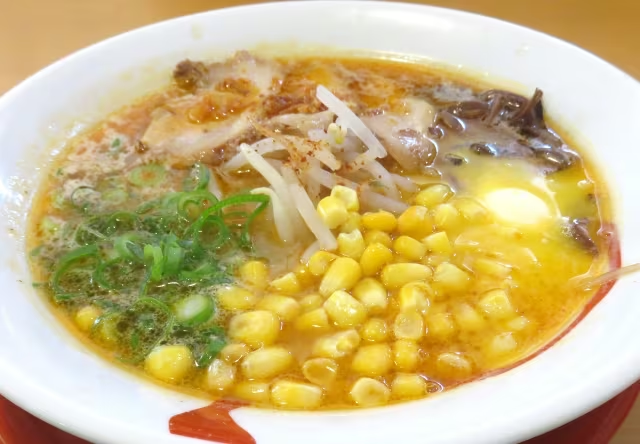
Northern Japan
In the northern regions of Hokkaido and Tohoku, where winters bring harsh temperatures and heavy snowfall, locals prepare heartier versions of miso soup that reflect their climate and lifestyle. These soups often incorporate fresh local seafood and robust root vegetables, with unique additions like butter in Hokkaido – a practice not commonly seen in other parts of Japan.
The northern Tohoku region makes their miso soup to combat the cold winters. They often use a darker, stronger miso and include plenty of root vegetables. Some areas are known for adding their local mushrooms, making the soup especially warming and nutritious.
Tokyo and Kanto
The Tokyo area has its own approach to miso soup, favoring a rich bonito dashi base. Their soups typically use darker miso varieties and keep things simple with classic combinations like tofu, wakame, and green onions. Many local breakfast spots serve this style.
Central Japan
Moving to central Japan, the Nagoya area has developed its own distinctive miso soup culture centered around their famous red miso. This dark, intensely flavored variety creates soups with remarkable depth, typically featuring locally grown vegetables prepared according to methods passed down through generations. The robust character of Nagoya’s miso soups perfectly complements the region’s bold culinary traditions.
Western Japan
In contrast, the western regions, particularly around Kyoto, take a more refined approach to miso soup. The ancient capital’s culinary heritage favors delicate white miso preparations that showcase seasonal vegetables with exceptional care. These soups reflect the elegant simplicity that characterizes Kyoto’s sophisticated food culture, with each ingredient chosen and prepared to create subtle, harmonious flavors.
Shikoku Region
A smaller island below the main island has its own unique take on miso soup. Shikoku is known for adding fresh bonito flakes just before serving, a practice that reflects the region’s famous katsuo (bonito) industry. Their soups often use sardine-based dashi, creating a distinctively rich broth that pairs well with local specialties like Kochi’s ginger or Tokushima’s sweet potatoes.
Southern Japan
At the southernmost main island, Kyushu’s miso soup stands apart for its use of barley miso, creating a unique flavor profile different from other regions. The proximity to the sea influences their soup making, with various local seaweed varieties frequently appearing in their bowls. Some areas in Kyushu even incorporate regional specialties like mentaiko (spicy cod roe), adding their own local touch to this national dish.
Health Benefit

Recent Japanese health studies have confirmed what generations of Japanese families have long known: miso soup offers numerous health benefits through its nutritious ingredients and fermentation process. A single bowl of miso soup contains only 35-50 calories but packs significant nutritional value. Using the standard amount of 13 grams of miso per serving provides about one-sixth of your daily salt intake, along with essential nutrients created during the fermentation process.
The fermented soybeans in miso provide essential nutrients that support overall health, including proteins and various vitamins not found in raw soybeans. Regular consumption of miso soup has been linked to improved digestion and better nutrient absorption, thanks to the beneficial enzymes created during fermentation. The combination of miso and dashi creates a particularly effective blend of nutrients that work together.
Miso soup serves as an excellent source of minerals and vitamins, particularly B1, B2, and E vitamins, which are essential for energy production and maintaining healthy nerve function. The soup also provides dietary fiber and minerals that support overall wellness. The warmth and salt content of miso soup can help prevent dehydration, making it particularly beneficial during hot summers or after physical activity.
How to make Miso Soup at home?
Ingredients
| For basic miso soup: |
| Dashi stock (made from kombu seaweed and/or katsuobushi) |
| Miso paste |
| Your choice of ingredients such as tofu, wakame seaweed, green onions |
| For homemade dashi: |
| 10cm piece of kombu |
| 2 cups katsuobushi (dried bonito flakes) |
| 4 cups water |
Step-by-Step Preparation
Place kombu in cold water and heat slowly until small bubbles appear.
Remove the kombu just before the water boils.
Add katsuobushi, bring to a boil, then strain. This creates your basic dashi stock.
Cut tofu into small cubes, rehydrate dried wakame seaweed, and finely chop green onions. The order of adding ingredients matters – harder ingredients should go in first.
Once your soup is hot (but not boiling), take a small amount of the hot dashi in a ladle.
Add the miso paste to this ladle and dissolve it completely using cooking chopsticks or a small whisk. This prevents lumps from forming in your soup.
Add the dissolved miso back to the pot and gently stir. Never let the soup boil after adding miso, as this will destroy its beneficial properties and affect the flavor. Add your chopped green onions just before serving.
Tips for Perfect Miso Soup
When making miso soup at home, a few key points will help you get the best results. The ideal temperature for dissolving miso is between 60-80°C – any hotter and you’ll lose the beneficial nutrients and good bacteria. That’s why it’s important never to let your soup boil after adding miso. If you need to reheat your soup, warm it gently without letting it reach boiling point.
Start with less miso than you think you need – you can always add more to adjust the taste, but you can’t take it away once it’s in the soup. Keep in mind that different types of miso have different salt levels, so you’ll need to adjust the amount based on which variety you’re using.
For the best results, always use fresh ingredients in your soup. The quality of your ingredients will directly affect the final taste. When you’re not using your miso paste, store it properly in the refrigerator with a tightly sealed lid to maintain its quality and flavor.
・Different types of miso have different salt levels, so adjust the amount according to your taste and the type you’re using
・Store miso paste in the refrigerator with a sealed lid
・When reheating, be careful not to let the soup boil
・Fresh ingredients will give you the best flavor
・Start with less miso – you can always add more, but you can’t take it away
Where to enjoy Miso Soup?
MISOJYU (味噌十)
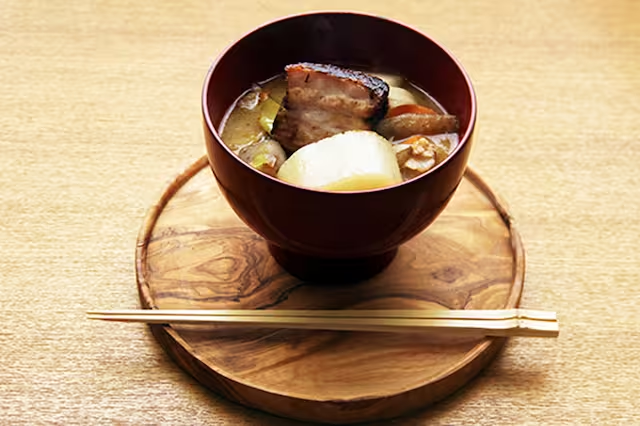
This specialist miso soup restaurant has locations in both Asakusa and Tokyo Skytree Town Solamachi. MISOJYU takes pride in their carefully crafted dashi, made from selected bonito flakes and kombu kelp, paired with their original miso blend. What makes their soups special is the generous portions of organic vegetables and ingredients – they believe miso soup should be hearty and filling, not just a side dish. Each bowl is thoughtfully prepared to bring out the best flavors of traditional miso soup.
Misomebore (みそめぼれ)

Located just 5 minutes from Roppongi Station, Misomebore offers something unique – miso soups made with miso paste from all 47 prefectures of Japan. This allows customers to explore the diverse world of miso, from white to black, red to barley miso, each with its own distinct character. Visitors can try different types side by side to compare the subtle differences in flavor and texture.
Ajien (味苑)

Just 2 minutes from Kameido Station, Ajien keeps things beautifully simple with four carefully crafted miso soup sets. Each bowl reflects their dedication to perfecting every element – from the miso blend to the dashi preparation and the cooking method for each ingredient. They focus purely on bringing out the true potential of miso soup.
Shiruko (志る幸)

Open since 1932, this traditional Japanese restaurant in Kyoto serves some of the city’s finest miso soup. They offer three choices: white miso from Kyoto’s famous Ishino Miso, red miso from Aichi Prefecture, or a clear soup. Their most popular choice is the white miso soup with silken tofu (600 yen), which shows off the gentle, rounded flavor of Kyoto-style white miso. The dashi, made from Rishiri kombu and Kagoshima bonito flakes, gives each soup a rich, complex taste. Their soups come with about 10 different ingredient options, including sea bream and yuba (tofu skin), starting at 800 yen.
Takeaway
Miso soup perfectly represents what makes Japanese cuisine special – it’s simple yet deeply satisfying, healthy yet delicious, and traditional yet perfectly suited for modern life. From its origins in ancient Japan to today’s busy households, this humble soup continues to bring comfort and nourishment to millions of people every day.
The beauty of miso soup lies in its versatility. While each region of Japan has its favorite way of preparing it, and every family has their special recipe, good miso soup always comes down to the basics – quality ingredients and proper preparation. As our lives get busier and food trends come and go, miso soup remains a constant, offering a warm, nourishing bowl that connects us to centuries of Japanese culinary wisdom.
If you are a fan of miso, click here or check out below!



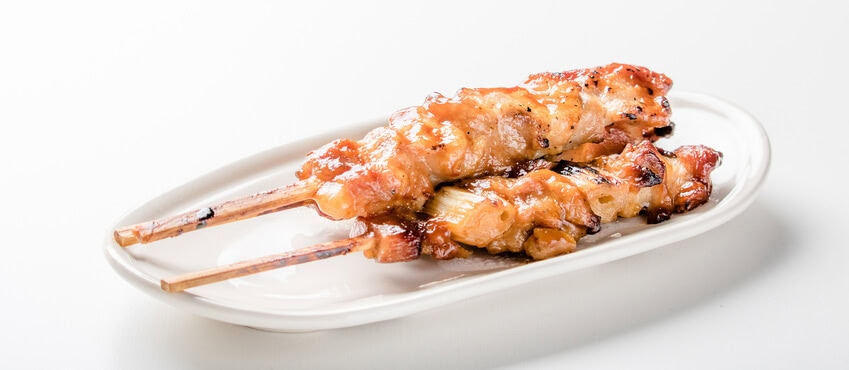











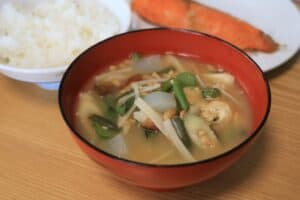


Comments